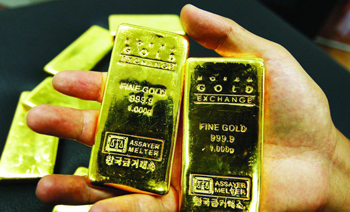London, Feb 18: Gold crept higher on Friday as investors opted for the safe haven qualities of bullion due to uncertainty about US and European politics as well as the direction of stock markets.
 Global equity markets lost momentum after setting record highs in the previous two sessions, partly due to disquiet about the policies of US President Donald Trump.
Global equity markets lost momentum after setting record highs in the previous two sessions, partly due to disquiet about the policies of US President Donald Trump.
“Gold is close to its recent multi-month high despite the strong dollar, due to an increase in volatility on the equity markets and more uneasiness on the political front, which is supporting the search for safe-haven assets,” said Eugen Weinberg, head of commodity research at Commerzbank.
Spot gold gained 0.2 percent to $1,241 per ounce by 1520 GMT, while US gold futures added 0.1 percent to $1,242.30. Gold, on track for a third week of gains, has risen nearly 8 percent in 2017. Concern over Trump's policies, as well as elections in the Netherlands, France and Germany this year, fueled gold's rise to a peak of $1,244.67 on Feb. 8, the strongest in nearly three months. “Dealers are extremely cautious about running the market higher as the March Fed rate hike debate will likely play out for the foreseeable future,” said Stephen Innes, senior trader at OANDA.
Strong recent US data has boosted expectations for a hike with Citi Research's barometer on US economic data surprises rising to its highest in over three years following a batch of stronger-than-forecast reports. Prospects of a stronger dollar and US Treasury yields after Fed Chair Janet Yellen said US interest rates may need to be raised in March had dragged gold to $1,216.41 on Wednesday, its lowest since Feb. 3. The dollar index rose 0.3 percent to 100.75 on Friday, recovering from a one-week low of 100.41 the day before. Holdings of SPDR Gold, the world's largest gold-backed exchange-traded fund (ETF), have risen 5.6 percent so far this month, the most since June 2016.
“The market seems to be quite supported by investment inflows into the ETFs and I think this will be the most important factor through the year as we expect investors to keep pouring money into gold ETFs,” Weinberg added.
Commerzbank expects gold to hit $1,300 by year-end. Spot silver fell 0.4 percent to $18.01 an ounce. The metal hit its strongest since Nov. 11 at $18.13 in the previous session. Platinum dropped 0.8 percent to $1,003.74. Palladium declined 1 percent to $784.22. The metal, used in emission-controlling catalytic converters for the automotive industry, touched its best since Jan. 24 at $794.90 in the prior session. It has gained over 16 percent so far this year.
“Palladium still appears to be finding support from the still buoyant automotive economy. What is more, palladium ETFs have seen inflows of a good 20,000 ounces in the last two days,” Commerzbank analysts said in a note.





Comments
Add new comment